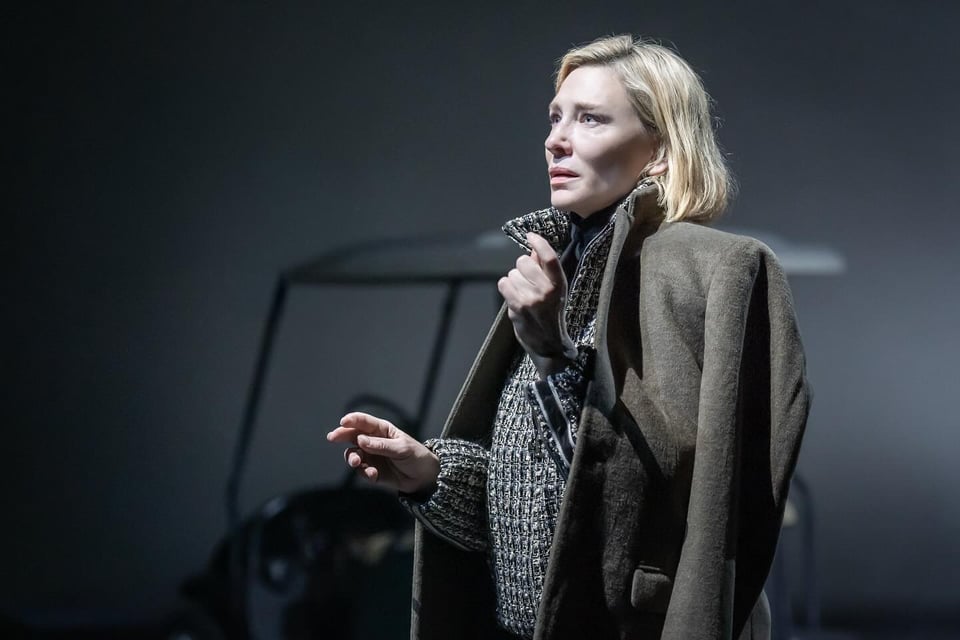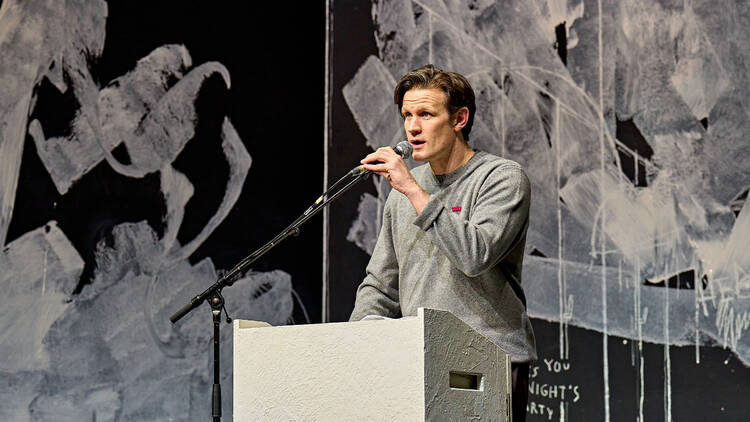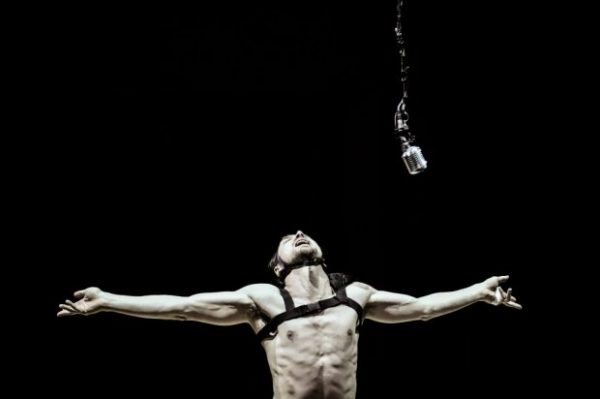Let Me Talk To The Seagull You Coward
An essay about Thomas Ostermeier and Duncan Macmillan's production of The Seagull at the Barbican Theatre (2025), or more specifically one moment in that show.

Kia ora koutou katoa and welcome back to Post-Electric, a blog about theatre and culture in the age of the profit-driven blackout.
I’m prepping this email from the bar of The Fire Station in Sunderland, where I’m on a day trip seeing a show for my 9-to-5. It’s kind of fucked up that the most time I’ve made for writing in the last month is this weekend, when I’m spending eight hours on trains running up and down England, but nevertheless, here we are.
This week’s blog (calling this a blog feels more honest, because a newsletter implies some level of regular service) is about Thomas Ostermeier and Duncan Macmillan’s production of The Seagull, which I saw at the Barbican Theatre three weeks ago, the day the season ended. Don’t ever say I don’t have my finger on the pulse.

This is a blog about The Seagull, the most recent collaboration between German director Thomas Ostermeier and his English language translator, the celebrated playwright Duncan Macmillan. That £150-stalls-seat extravaganza wrapped at the Barbican Centre earlier this month, ‘modernising’ and ‘reimagining’ Chekhov’s tragic love spiderweb with all the tricks and transgressions that befit its price tag, including Grand Dame of Australian Theatre Cate Blanchett and a supporting cast stacked with Stars of the Stage and Screen. But before I blog about The Seagull, I have to blog about An Enemy of the People, Ostermeier and Macmillan’s previous West End collabo. I have to blog about that £150-stalls-seat extravaganza, which ‘modernised’ and ‘reimagined’ Ibsen’s classic moral tragedy in a similar fashion.
The titular Enemy of the People is Thomas Stockmann, a medical man who discovers that his small town’s famed mineral baths are being contaminated by water pollution from a factory upstream and are making visitors sick. Shut down by the Board of the baths (his employers), harangued by the town’s mayor (his brother), and let down by the local press (including his BFF), Thomas takes increasingly drastic measures to go public with this scandal.
So Act Four of Enemy of the People is a town forum that Thomas himself has called. But then his brother blindsides him in front of the town, moving that Thomas be barred from talking about the very matter on which he has called the meeting. No matter, says Thomas, at the end of his tether. If the town’s here, he might as well say something - if not about the baths, then about the corruption, moral perfidy and rank stupidity at the heart of his town and his country.
In this 21st century update, Thomas unleashes on the “unprecedented crisis” that is the liberal capitalist world order: the powerful feeding people to a machine of infinite growth, tricking them into believing that migrants and socialists are the cause of their immiseration, hiding behind the bloodless cruelty of corporate structures and government processes to avoid taking accountability or demonstrating humanity. “This society deserves its own extinction.”

In the original text, the town then riots against their medical man, now the titular enemy of the titular people. Osteremeier and co-writer Florian Borchmeyer take a different approach to this moment. They ask instead, what would have happened if Thomas’ audience had listened instead of retaliated. What might they have said if they had seen what he had gone through to get to this moment? What if his audience were us? What might we say, tonight, in this theatre?
And so Aslaksen - moderate Aslaksen, so reasonable and apolitical that she can be both a newspaper editor and the Leader of the Landlord’s Committee - asks us to raise our hands if we agree. A number of us do. Then, she passes mics to the ushers so we can tell her why we hold such an - clutches pearls - illiberal position. Audience members speak up about the absurdity of a system that allows for both billionaires and food banks; they talk about their fear of creeping fascism across Europe, Asia and America; they remark on the inherent inequality of making a citizen’s assembly out of a £150-stalls-seat audience. (I’m told later that this comes up most nights.)
And there I am in the stalls getting so angry in this moment, so gut twisting acid roiling opinions clawing at my throat mad. Mad at our kindergarten teacher-voice moderator mischaracterizing Thomas’ position and explaining why better things aren’t possible. Mad at the guy a few seats away who keeps muttering ‘rubbish’ in response to the people on the mic. Mad at the state of this fucking city, this fucking country, this fucking world, that tries to con us into believing that we don’t deserve something better, fairer, more sustainable than what we’ve got. And then Aslaksen says some shit about how Thomas was calling us idiots because we were the ‘liberal majority’, and I get mad enough to put up my hand and get a mic and say some shit about no, actually, you’re wrong.
I thought about this moment a lot in the aftermath of The Seagull. To be clear, I loved The Seagull - it’s got Zachary Hart singing Billy Bragg and hooning around on a quad bike and it’s got Kostya writing a multidisciplinary work for the Oculus Rift and it’s got Cate flouncing and sighing dramatically tearing off her mic pack in the heat of an argument. Like Enemy of the People, it’s creating spectacle out of showing your work, leaning on decades of deconstructive forms to intensify the play’s already-intense throughlines of longing, alienation and self-destruction. It’s thrilling, man. It’s grand and painful and so much fun.

There’s also a ‘town hall’ moment in this production, and because I love so much of the production I had been approaching this moment with some kind of generosity. The moment kicks off deep into the flirtation between idealistic young actress Nina (Emma Corrin, nervy and excited and doing great work) and the author Trigorin (Tom Burke, making selfish narcissism feel so fuckin chill), older and famous and clearly dtf. Trigorin, luxuriating in Nina’s adulation by pretending he doesn’t care about it, asks her, “What use are stories when the world is ending? We don’t need exquisitely wrought explorations of the human condition - we need activists. Campaigners.” He namedrops Angela Davis, Bernadette Devlin, Marsha P Johnson. Then the house lights come up. He takes a mic, walks out onto the catwalk that cuts into the audience, looks out at us. And he asks, “well? What do you think?”
And, on the afternoon I see it, the town hall is silent. No one says anything back.
Nina punctures the moment, telling Trigorin that stories ‘saved’ her, and we move on. But I spend the rest of the scene half-distracted by what I think is a missed opportunity here. It can’t be that Burke expects to just stand there, posing a question that he doesn’t expect us to answer - can it? Barely anything is being done here to bring us in, to prompt us to actually break the unspoken contract between performer and spectator and respond.
In Enemy of the People, the town hall is a clear intervention. All the characters are talking to us, we’re being handed microphones, we’re being goaded into responding by the characters and encouraged by everyone else’s responses. It’s forum theatre as setpiece, creating spectacle out of a form with revolutionary origins by bringing it into a space (the text of Enemy of the People, and also the West End) that’s hostile to its principles. It doesn’t change the course of the play - Thomas is still brought low by his brother and then exploited by his father-in-law the factory owner, buying shares in the baths the night of the town hall so that he can compromise Thomas and bring him to heel. But it’s a moment for us to consider how little voice we individually have in a modern liberal democracy, how often collaborative or radical opportunities to change the shape of our civic life are constrained, controlled and even killed by capital and bureaucracy and process. We get to yell and vent and tell a captive audience just how shit fucked everything is, then we get to watch what power and capital will do to stop us from yelling. And for all that to hit as intended, they need to get us to talk.

Nothing Trigorin is doing here is designed to get us to talk, and so I’m struggling with the purpose of his question to the class. What’s it doing? Who’s it for? Is Ostermeier weaponising our emaciated spectatorship to prove Trigorin’s point and show that no-one really disagrees with him? Is it a moment to demonstrate how Trigorin lingers in his self-importance, underlining the significance with which he treats his pronouncements in the same way that the other characters use the catwalk and microphones to underline aspects of their character? Is it meant to make us talk? Is it meant to fail? Is it all of the above?
As I understand, this kind of provocation-about-itself pops up often in Ostermeier’s work. In his 2019 article Performing silence as political resistance: Audience interaction and spatial politics in Thomas Ostermeier’s Richard III, Alessandro Simari describes a similar moment in Ostermeier’s 2017 production of Richard III at the Barbican, when Richard addresses a couple in the front row by asking the man, ‘did you eat her pussy this morning?’1 The man often answers: sometimes in the negative, sometimes in the affirmative, sometimes enthusiastically so. On the night Simari saw the production, though, the man refused to answer, setting off a chain reaction of people yelling at the man to participate and yelling at Richard to fuck off.

Simari describes the moment as ‘theatrical failure’, with Richard failing to “enfold an audience’s theatrical engagement into the diegesis to become political consent.” In that performance, the silence was a resistance, in a weak kind of way, denying the implied in-fiction assent to tyranny that Ostermeier and his team had designed and reducing Richard to his performer, Lars Eidinger, passive-aggressively pleading with an audience member to engage because otherwise ‘the play won’t work’. In The Seagull, though, Trigorin’s appeal to the crowd for discourse is so open-ended that it could stand for anything. It could be a moment for us to challenge him and pop his insincerely self-deprecating bubble; it could be a moment for us to agree and lament the state of the world today. Or it could be a moment for introspection, to spur off a dozen blogs like this. Maybe the silence is fine as long as people are thinking about it. (Embarrassingly, writing this is maybe convincing me that it’s doing this.)
So Trigorin stands on that catwalk and lets the room sit in it. Brechtian multiverse theory: there are a hundred different versions of this moment and they all cast new light on our social order because we can see them all at once. And maybe it’s a mistake to be looking for an emotional truth in that. Maybe I’m asking for certainty where the intention is plurality, ambiguity. But I look at how angry I was in that town hall in Enemy of the People, how I felt so deeply that I needed to say something when Aslasken attempted to divide us and convince us that we do not share a struggle. Then I look at The Seagull, and I look at this moment with Trigorin, this lofty provocation, and I wonder why I didn’t feel like I needed to say anything.
That's all for this week! I’m working on the next issue now, which is likely to be full of Scraps. If you have thoughts about this one, I’m pretty sure you can email me here. And if you liked it, please share it out!
Until then, thanks for reading! Keep safe, keep well, keep sinewy,
Adam
Huge thanks to Alessandro for responding to my cold email with a copy of his paper! People, email your academics. That shit works! ↩